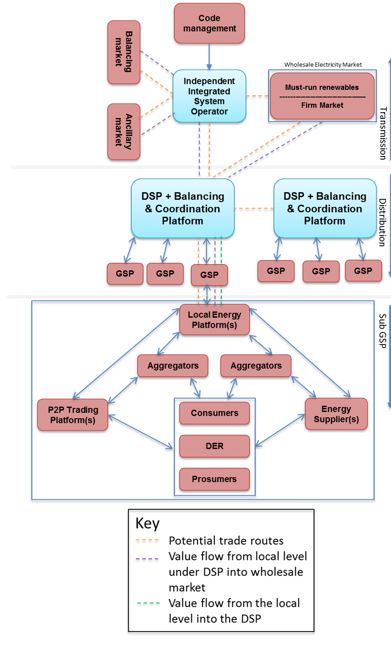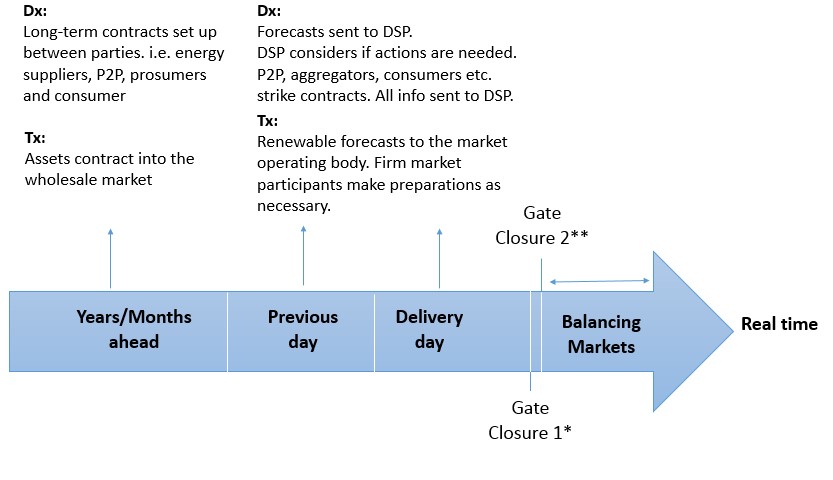Blog 4: Market Design Issues for a smart, flexible, sustainable and secure energy system: Proposed design
Thomas Pownall
24th July 2019
The vision
As mentioned Blog 2 there are several academics who have proposed their own electricity market design, each with their own vision and goals. These designs have intended outcomes with subsequent winners and losers.
We argue that the proposed electricity market design in this blog suits an energy efficient system based on renewables, storage, DSR and interconnection, fully utilising distribution resources. The proposal consciously enables these resources but does not exclude ‘traditional’ supply. It is not only their resource characteristics which need to be considered, but also the role of the end consumers who should be at the heart of their energy system.
The 5 main objectives of this vision are summarised below:
- An energy efficient system based primarily on renewable generation requires an electricity market design which values, and incorporates, their characteristics.
- Assets should be able to trade with whomever they wish, be this in their local neighbourhood or into national markets
- Reduction of overall GHG emissions stemming from the electricity system (to include heat or mobility when via electricity) should be delivered e. to meet decarbonisation targets
- Consumer protection should be in place, whether prices, security of supply, equity or data.
- All assets – transmission or distribution / supply, demand and storage / energy or system – should have their value revealed
Key to facilitating these objectives, Blog 4 electricity market design is underpinned by technological developments. These are not bound to improvements in renewable and storage technologies but also in the deployment of all DER, and in system operation changes (for example from smart meters) and in new business models (such as P2P networks)
The proposed electricity market design schematic
Figure 1 below, is a schematic of the electricity market design. For illustrative purposes, this schematic has split our energy system into three levels, transmission, distribution, and sub Grid Supply Point (GSP). The reason for this is to reflect the different and emerging opportunities that can be utilised at these levels.

Figure 1: The schematic of the proposed electricity market design
Brief summary of each level
Below is a high level summary of what is undertaken at each level. The electricity market design is formed of existing actors, evolution of current bodies as well as the introduction of new ones. The roles of these actors was described in detail in Blog 3 so only a brief summary occurs below:
Sub-GSP:
- Multiple actors trading amongst each other and into the DSP Pool
- Prosumers and DER trading with aggregators, LEM’s, P2P and DSP Pool
- Prosumers trading with their neighbours
- Assets trading up via the DSP into the wholesale market
- All trades being known by the DSP to give them an eye over their network and whether they need to take action / facilitate something in some way
- Energy resource providers provide a similar service as today (i.e. as suppliers) for those consumers who do not wish to be engaged
This illustration represents the vision that prosumers and consumers should be able to trade with whoever they wish. This will also allow for a sense of community among trades for those who wish it (for example, the Piclo trials when an premium price for electricity was accepted by a member of the public as a means to support their local generator [1]).
Distributed Service Provider (DSP) level:
- Coordinating their network
- Obligated to balance their local region
- Operating a balancing market and an ancillary market in addition to facilitating the trade of assets in their geographical regions into the IISO wholesale balancing and ancillary market.
- Facilitating the access into the wholesale market for assets located at the Sub-GSP level
- Trading with other DSPs when necessary
- Receiving and giving instructions with the IISO at times when services are needed or in order to meet certain targets (i.e. EV connections / heat pump installations etc.)
- Facilitating the discovery of value of assets
- Provider of system data
This reflects a system in which the sub GSP distribution area is balanced at local levels rather that nationally as is currently undertaken. This allows local trading and dealing with large quantities of granular data to reveal unique local characteristics and values which one central entity may not be able to efficiently process.
Independent Integrated System Operator (IISO):
- Oversees the implementation of zero-carbon strategies
- Is system operator at transmission level
- Oversees code management
Wholesale Market Manager:
- Operates the Must-Run Renewable Market as Priority
- Operates the Firm market as a residual for when forecasted renewable generation is not sufficient
- Operating a more open and transparent balancing and ancillary market
The wholesale market is split into two parts. The first is for the deployment of variable renewable generation and the latter acts as a residual of firm powered generation which acts as a residual to aid in meeting the intermittency from the former market. This places variable renewable generation at the forefront of the electricity system, whilst ensuring that there is the much needed flexible capacity on the system.
There are also similarities with this proposed wholesale market and our current electricity market design with a balancing and ancillary market. However, these are much more open to assets with lower clip sizes and different technologies to reflect the increasingly decentralised energy system in the UK.
Timeline of events
Over time there are different functions that occur at the Distribution and Transmission levels. One of the larger changes which will be needed is the incorporation of two gate closure periods.
The first (*) is for the DSPs, 10 minutes before real time and 5 minutes before Gate Closure 2 (**) opens. They will try to balance their geographical regions as much as possible utilising their pool market.
At the second gate closure (**) which is 5 minutes before real time, the DSPs will submit their final physical notifications to the market manager who at this point will have an overview of the entire system made up of its geographic regions. They will then open up their balancing market and balance the system accordingly. This is illustrated in Figure 2 below.
Figure 2: A timeline of events
Concluding remarks
In the fourth blog of this series we have introduced the electricity market design, the guiding vision, the function of each level and how this market may operate over time. The other blogs in this series are:
Other blogs in this series
As only so much depth can be achieved through a blog, and it’s a very one way process. Please feel free to contact Tom Pownall on t.pownall@exeter.ac.uk for more detail.
Reference
[1] Piclo, 2016. A glimpse into the future of Britain’s energy economy [online]. Available from: https://piclo.energy/publications/piclo-trial-report.pdf [Accessed 17 Jun 2019].
Related Posts
« Previous Electricity Market Design 3: The institutional glue to link markets & networks Electricity Market Design 5: Summary of blog series Next »








